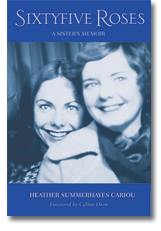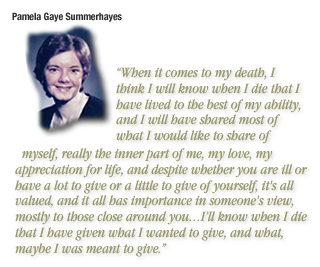Heather Summerhayes Cariou made a promise to her sister, Pam, that she would tell Pam’s story after she died.
 The result was the book, Sixtyfive Roses. The accompanying Web site tells more:
The result was the book, Sixtyfive Roses. The accompanying Web site tells more:
Heather’s sister Pam was diagnosed with Cystic Fibrosis at the age of four and given only a short time to live. Heather promised to die with her sister, but as Pam fought the limits of her prognosis, she instead taught Heather how to live. “Sixtyfive Roses” is the way Pam pronounced the disease that altered the lives of her siblings and parents, who in turn helped alter the community’s response to the disease by founding the Canadian Cystic Fibrosis Foundation.
How many causes have been advanced, how many diseases have been researched, how many cures are closer to being found, because victims and survivors have told their stories?
A sisterly storytelling similar to Sixtyfive Roses is Nancy G. Brinker’s telling of her sister Susan G. Komen’s story of living and dying with breast cancer, which resulted in more than a billion dollars raised for breast cancer through Susan G. Komen for the Cure®.
I think of the famous — Christopher Reeve telling his quadriplegia story to promote spinal-injury research, Michael J. Fox’s Parkinson’s disease story raising millions to research that illness — and the less famous like Pam and Susan.
Once again, the power of story generates progress, compassion, and involvement in attacking society’s ills.

